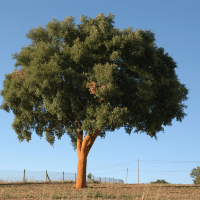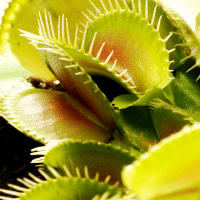Endangered plants are species that face a high risk of extinction in their natural habitats. They are threatened by factors like habitat destruction, climate change, invasive species, and overexploitation. Conservation efforts are crucial to protect these plants and maintain biodiversity in ecosystems.
Top 10 Endangered Plants Names
Below are the top 10 endangered plants names with pictures.
| Endangered Plants Names | Pictures |
| 1. Baobab Tree |  |
| 2. Rafflesia |  |
| 3. Titan Arum |  |
| 4. Black Bat-Flower |  |
| 5. Dragon Tree |  |
| 6. Bois Dentelle |  |
| 7. Cork Tree |  |
| 8. Venus Fly Trap |  |
| 9. Baseball Plant |  |
| 10. Green Pitcher Plant |  |

10 Interesting Facts About Endangered Plants
1. Baobab Tree:
- Baobab trees are known for their distinctive, swollen trunks, which can store thousands of gallons of water. This adaptation allows them to survive in arid regions of Africa.
- Some baobab trees are estimated to be over 6,000 years old, making them some of the oldest living organisms on Earth.
- The baobab fruit is edible and is rich in vitamin C, antioxidants, and minerals. It has gained popularity as a superfood in recent years.
2. Rafflesia:
- Rafflesia arnoldii is known as the world’s largest flower, with some blooms measuring over three feet in diameter and weighing up to 24 pounds.
- Despite its impressive size, the Rafflesia has no leaves, stems, or roots and is a parasitic plant that relies on the Tetrastigma vine for its nutrients and support.
- The Rafflesia emits a strong odor similar to rotting flesh, earning it the nickname “corpse flower.” This foul smell attracts flies, which help in pollination.
3. Titan Arum (Corpse Flower):
- The Titan Arum is another contender for the title of the world’s largest flower, famous for its enormous inflorescence, which can reach heights of up to 10 feet.
- It is called the “corpse flower” due to its pungent smell, resembling that of a decaying animal. The odor is strongest during the peak of its short bloom, attracting pollinators like beetles and flies.
- The Titan Arum’s flowering event is rare and unpredictable, sometimes occurring only once every several years.
4. Black Bat-Flower:
- The Black Bat-Flower (Tacca chantrieri) is a unique and exotic-looking plant native to Southeast Asia.
- It gets its name from its bat-like appearance, with long, dark whiskers resembling bat wings and a center that looks like a bat’s face.
- Despite its eerie appearance, the Black Bat-Flower is not carnivorous and obtains its nutrients through regular soil-based methods.
5. Dragon Tree:
- The Dragon Tree (Dracaena draco) is a peculiar-looking tree native to the Canary Islands and parts of Africa.
- This tree has a unique umbrella-like canopy and a thick, resinous red sap often referred to as “dragon’s blood.” The sap has been used for various traditional purposes, including medicine and dyes.
- The Dragon Tree’s resin was highly valued in ancient times, and it was even considered to be the blood of dragons in certain mythologies.
6. Bois Dentelle:
- Bois Dentelle (Elaeocarpus bojeri) is an extremely rare tree found only on the island of Mauritius in the Indian Ocean.
- Its name, “Bois Dentelle,” means “lace wood” in French, inspired by the intricate, delicate patterns of its leaves.
- The tree’s decline is primarily due to habitat destruction, and conservation efforts are in place to protect this endangered species from extinction.
7. Cork:
- Cork is harvested from the bark of the Cork Oak tree (Quercus suber) without causing harm to the tree itself.
- Cork is lightweight, elastic, and impermeable to liquids and gases, making it an ideal material for wine stoppers, flooring, insulation, and various other products.
- The Cork Oak forests play a crucial role in preserving biodiversity, supporting unique ecosystems, and combating desertification in certain regions.
8. Venus Fly Trap:
- The Venus Fly Trap (Dionaea muscipula) is a carnivorous plant native to specific regions in North and South Carolina, USA.
- Its leaves have specialized trigger hairs that, when touched by prey, cause the two lobes of the leaf to snap shut rapidly, trapping insects inside.
- Contrary to popular belief, the Venus Fly Trap does not rely solely on insects for nutrients and can survive in the wild without catching prey.
9. Baseball Plant:
- The Baseball Plant (Euphorbia obesa) is a small, globular succulent native to South Africa.
- Its name comes from its shape, which resembles a baseball or a sphere-like cactus.
- The plant is critically endangered due to illegal collection and habitat destruction, making it highly sought after by collectors.
10. Green Pitcher Plant:
- The Green Pitcher Plant (Sarracenia oreophila) is a carnivorous plant found in the southeastern United States.
- It has specialized pitcher-shaped leaves filled with a liquid that attracts, traps, and digests insects.
- The Green Pitcher Plant is threatened by habitat loss, pollution, and illegal collection, making conservation efforts crucial to its survival.
Related:






